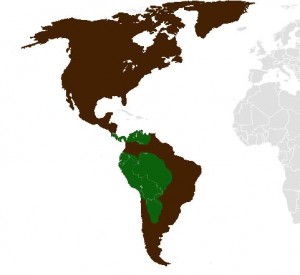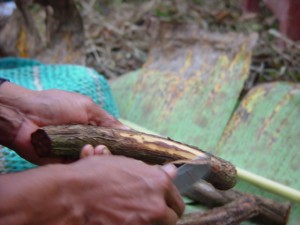Banisteriopsis caapi/inebrians, (sometimes referred to colloquially as ayahuasca or yajé) are two species of large lianas (vines) native to the rainforest regions of Central and South America. Usually two (but sometimes more) strands of the vine twist together. Although only two species have been differentiated scientifically, Amerindian cultures which traditionally use the plant acknowledge as many as six different “kinds” with different potencies and effects. For example, among the Tukano of the Colombia Vaupés, Suána-Kahí-má (“Kahí of the red jaguar”) grants red visions while Mé-né-kahí-má brings visions of green snakes.
The interior of the vine is made up of five or more small, parallel filaments bunched together inside a casing, as seen in the vine sections pictured above. The similarity of the interior to a typical jaguar spot is striking, and provides a strong visual argument for the relationship between jaguar and vine seen in the art on the previous page. The basic Amerindian worldview favors analogies between different phenomena that aren’t random, but rather meaningful. Therefore a vine which is itself spotted and turns you into spotted beings makes perfect sense in this cyclical way of thinking.
Both species of vine have smooth brown bark, dark green oval leaves, and pink or rose-colored flowers. The bark contains the entheogenic properties, and is therefore the part that is harvested. Preparation methods vary, but most involve boiling the bark before adding other plants to make the ayahuasca drink. Caapi is a sacred plant, often called a plant teacher, whose spirit is considered to open the visionary realm up to humans if treated with respect.
In art, the vine pattern is surprisingly common in ancient Central and South American cultures. Its twisting strands seemingly inspire many variations on the heliacal motif. The vine often occurs with jaguar motifs connecting the sacred plant to the resulting transformation into the shaman’s animal self.

